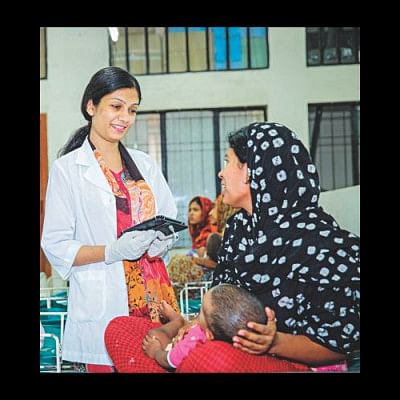Healthcare In Bangladesh: Women to lead the way

Back in the late 1980s and early 1990s, the government of Bangladesh was proactively focusing on improving the healthcare scenario of the country. A series of awareness advertisements were aired on national television, focused on educating women about nutrition, vaccination, pregnancy and neonatology.
The strategy seems to have worked well. Since the 1990s, polio has been virtually extinct, child mortality rate has decreased by more than 200 percent, neonatal mortality rate has decreased by approximately 71 percent, and so on.
Other factors also contributed to these positive numbers. But there was one common approach in each initiative. Each and almost every initiative was targeted towards women. Historically, the women of this delta have been the source of care for the family and in charge of the household. They have decided on how the children will be raised, what the family will eat, and how the family healthcare will be managed.
Women have also played a key role in bringing about changes in communities. Not only through the female front-line health workers deployed to reach every household but also through those women who were empowered to take control of their own health and reproduction. Female health workers, recruited to deliver door-to-door family planning services, are behind a rapid fall in fertility from seven births per woman in 1971 to 2.3 in 2010. Contraceptive use also rose from 10 percent in 1970 to around 62 percent to the present day, contributing to the speed and magnitude of improvements in mortality rates.
Whether it is as professional healthcare advocates or as home managers, women are important providers, as much as they are recipients, of healthcare in their homes and wider communities. According to a report by the Lancet Commission on Women and Health, globally women contribute around USD 3 trillion in healthcare annually. Women play a vital role in the global healthcare workforce as nurses, midwives, community health workers and doctors. In some countries, 90 percent of nurses are women.
There is also contribution of women which usually goes unpaid and unnoticed. This includes contributions made by women giving care in the home. It is estimated that women's unpaid contributions equate to 2.35 percent of global GDP, with a large variation around this depending on assumptions made about wage rates and other factors. An ageing population, living longer but experiencing chronic diseases, means a larger demand for care, much of which is traditionally provided by women. This is more relevant for Bangladesh because the average life expectancy has risen significantly in our country over the past 30 years.
However, gender inequity is prevalent in healthcare too. And the predicament is vastly visible in the rural front. Gender roles and differences influence health status—how society values women (girls) and men (boys) differently and the accepted norms of male and female behaviour influence health problems and outcomes. For example, preference for a male child can influence allocation of scarce household resources, including food and money, for healthcare.
Gender norms affect health-seeking behaviours and the use of healthcare services. Women and men often have different attitudes towards medical care (including preventative care), and women may not be able to access healthcare if the services are not seen as culturally appropriate. Furthermore, women may not have the resources to pay for healthcare services and, in some cases, require the permission of a male relative.
The arrival of digital services in the healthcare sector may affect how women are exposed to quality healthcare or how they choose to lead it. As of January 2019, approximately 92 million people in Bangladesh are exposed to the internet. Even though there is no information available on the female population reaping the benefits of the internet, an assumption of even 30 percent covers a lot of ground. Women can easily login to international sites such as WebMd, Medscape or local platforms like Tonic, and access quality healthcare immediately. The opportunities are now vaster and easier to access.
Active participation of women in the healthcare sector is also optimistic. Medical colleges for women are now operating all over the country. This will result in a significant increase in female doctors and nurses. The social taboos lingering around female healthcare somehow have a silver lining to it. Government and non-government organisations are employing female healthcare professionals throughout the country to reach out to women and girls on the receiving end of healthcare facilities.
When women thrive, all of society benefits, and succeeding generations are given a better start in life. The number of working women increased to 18.6 million in 2016-17 from 16.2 million in 2010. Bangladesh secured the 47th position among 144 countries in 2017 as per the Global Gender Gap Report. Therefore, it would not be futile to expect female dominance in the healthcare sector. We can only expect positive outcomes from that.
Dr Divleen Jeji is Head of Healthcare and Digital Channels, Telenor Health.
Email: [email protected]

 For all latest news, follow The Daily Star's Google News channel.
For all latest news, follow The Daily Star's Google News channel. 


Comments